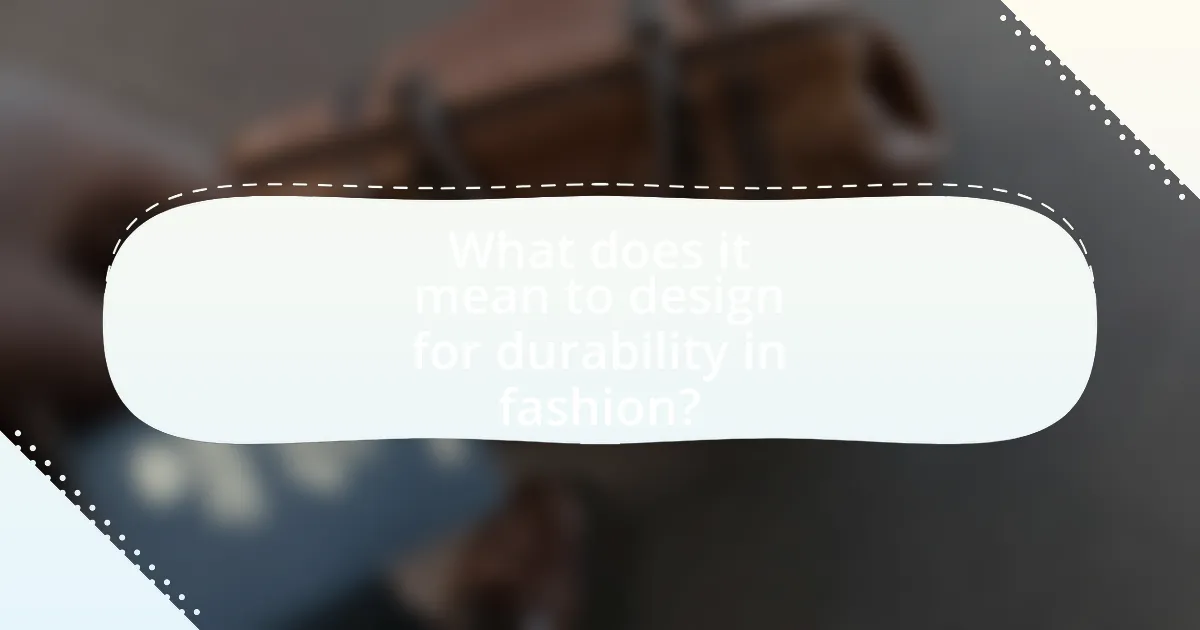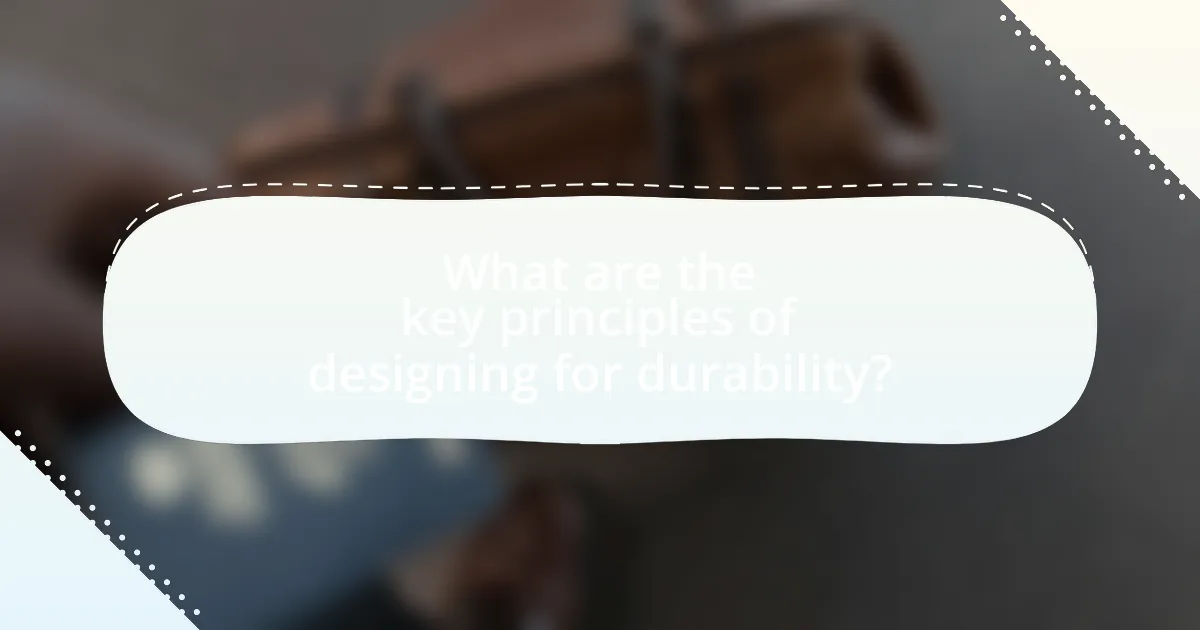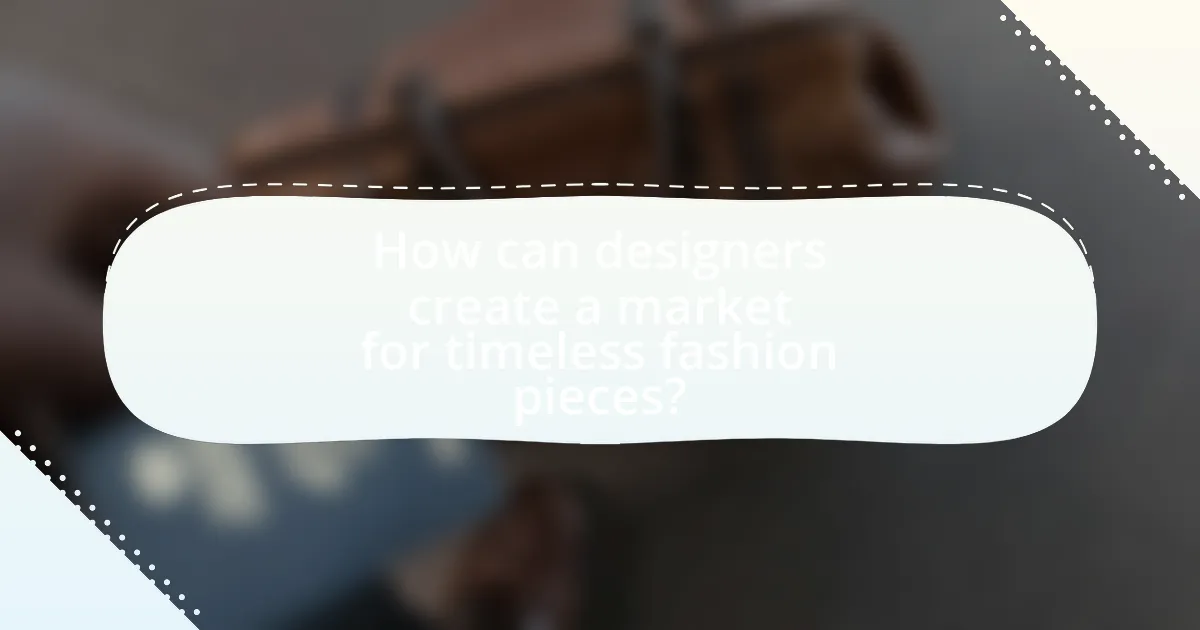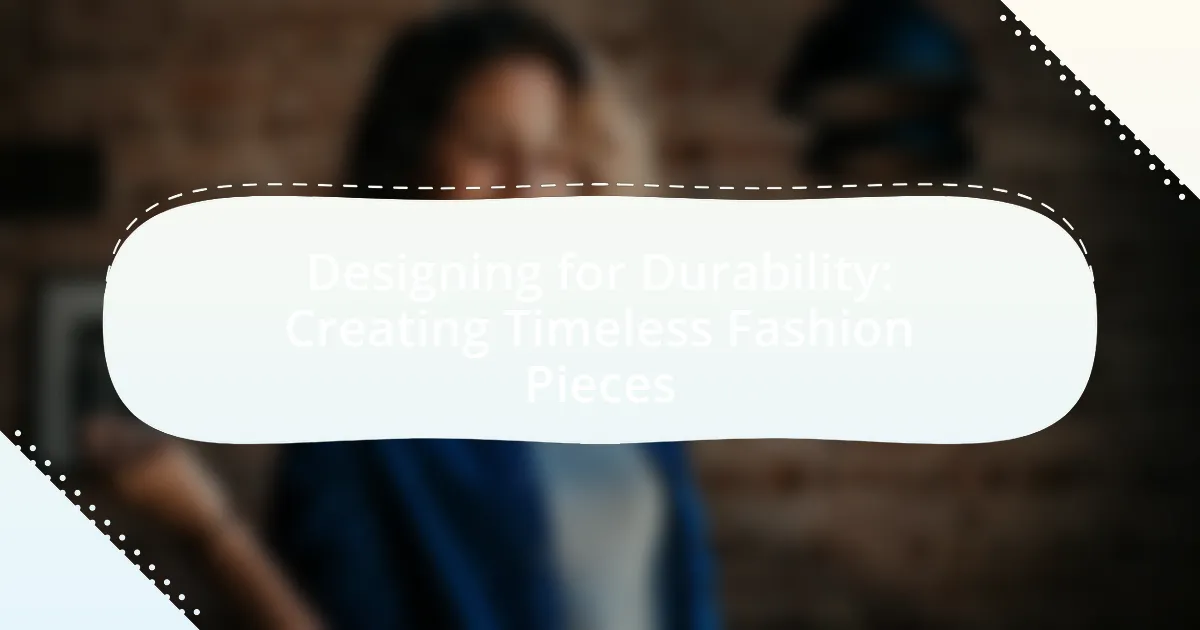The article focuses on the concept of designing for durability in fashion, emphasizing the importance of creating garments that are long-lasting and sustainable. It explores how durability impacts the lifecycle of fashion pieces, highlighting the role of high-quality materials, craftsmanship, and timeless design in extending the lifespan of clothing. Key principles for achieving durability include selecting robust materials, employing effective construction techniques, and integrating sustainability practices. The article also addresses the economic implications of durable fashion, consumer misconceptions, and practical tips for designers to create timeless pieces that remain relevant over time.

What does it mean to design for durability in fashion?
Designing for durability in fashion means creating garments that withstand wear and tear over time, ensuring longevity and sustainability. This approach involves selecting high-quality materials, employing robust construction techniques, and considering timeless styles that remain relevant beyond seasonal trends. Research indicates that durable fashion can significantly reduce waste; for instance, a study by the Ellen MacArthur Foundation highlights that extending the life of clothing by just nine months can reduce carbon, water, and waste footprints by 20-30%.
How does durability impact the lifecycle of fashion pieces?
Durability significantly extends the lifecycle of fashion pieces by ensuring they withstand wear and tear over time. When fashion items are designed with high-quality materials and construction techniques, they maintain their aesthetic and functional integrity longer, reducing the frequency of replacement. For instance, a study by the Ellen MacArthur Foundation highlights that durable clothing can reduce environmental impact by minimizing waste, as consumers are less likely to discard items that last longer. This relationship between durability and lifecycle not only benefits consumers through cost savings but also contributes to sustainable fashion practices by decreasing the overall demand for new garments.
What materials are best suited for creating durable fashion items?
High-quality materials such as leather, denim, and wool are best suited for creating durable fashion items. Leather is known for its strength and longevity, often lasting for decades with proper care. Denim, particularly in heavier weights, offers resilience and can withstand wear and tear, making it a staple in durable fashion. Wool is naturally resilient, resistant to wrinkles, and can regulate temperature, contributing to its durability. These materials have been historically favored in fashion for their ability to maintain structure and appearance over time, reinforcing their status as ideal choices for long-lasting garments.
How does craftsmanship influence the durability of fashion pieces?
Craftsmanship significantly enhances the durability of fashion pieces by ensuring meticulous attention to detail and high-quality materials. Skilled artisans employ techniques such as reinforced stitching, proper fabric selection, and precise construction methods, which collectively contribute to the longevity of garments. For instance, a study by the Fashion Institute of Technology found that garments made with superior craftsmanship can last up to five times longer than mass-produced items, highlighting the direct correlation between craftsmanship and durability.
Why is timelessness important in fashion design?
Timelessness is important in fashion design because it ensures that garments remain relevant and desirable across different seasons and trends. This relevance allows consumers to invest in pieces that do not quickly go out of style, promoting sustainability by reducing waste associated with fast fashion. Historical examples, such as the little black dress popularized by Coco Chanel in the 1920s, demonstrate how timeless designs can endure for decades, remaining a staple in wardrobes worldwide. Additionally, a study by the Ellen MacArthur Foundation highlights that extending the life of clothing by just nine months can reduce carbon, water, and waste footprints by 20-30%. Thus, timelessness in fashion design not only enhances consumer value but also contributes to environmental sustainability.
What characteristics define timeless fashion pieces?
Timeless fashion pieces are characterized by their versatility, quality craftsmanship, and enduring style. Versatility allows these pieces to be worn across various occasions and seasons, making them a staple in any wardrobe. Quality craftsmanship ensures durability and longevity, often involving premium materials and meticulous attention to detail. Enduring style refers to designs that transcend trends, remaining aesthetically pleasing over time. For example, the little black dress, designed by Coco Chanel in the 1920s, exemplifies these characteristics, as it continues to be a fashionable choice nearly a century later.
How can designers ensure their creations remain relevant over time?
Designers can ensure their creations remain relevant over time by focusing on timeless aesthetics, quality materials, and adaptability to changing trends. Timeless aesthetics involve creating designs that transcend seasonal trends, allowing pieces to be worn across various contexts and generations. Quality materials contribute to durability and longevity, ensuring that the garments withstand wear and maintain their appeal. Additionally, adaptability allows designers to incorporate elements that can be easily updated or styled differently, keeping the pieces fresh and relevant. Historical examples, such as the enduring popularity of the little black dress, illustrate how these principles can lead to lasting relevance in fashion.

What are the key principles of designing for durability?
The key principles of designing for durability include selecting high-quality materials, ensuring robust construction, and prioritizing timeless design. High-quality materials, such as natural fibers or advanced synthetics, resist wear and tear, contributing to the longevity of the product. Robust construction techniques, like reinforced stitching and durable fastenings, enhance the structural integrity of the item, preventing premature failure. Timeless design focuses on classic aesthetics that remain appealing over time, reducing the likelihood of obsolescence. These principles are supported by industry practices that emphasize sustainability and long-term value, as seen in brands that prioritize durability in their product lines.
How can sustainability be integrated into durable fashion design?
Sustainability can be integrated into durable fashion design by utilizing eco-friendly materials, implementing ethical manufacturing processes, and promoting circular fashion practices. Eco-friendly materials, such as organic cotton, recycled polyester, and Tencel, reduce environmental impact and resource consumption. Ethical manufacturing processes ensure fair labor practices and minimize waste, as seen in brands like Patagonia, which emphasizes transparency in its supply chain. Additionally, promoting circular fashion practices, such as designing for disassembly and encouraging garment recycling, supports longevity and reduces landfill waste, aligning with the principles of sustainable fashion.
What role does ethical sourcing play in creating durable pieces?
Ethical sourcing significantly contributes to the creation of durable pieces by ensuring that materials are obtained responsibly and sustainably. When brands prioritize ethical sourcing, they often select high-quality materials that are not only environmentally friendly but also designed to withstand wear and tear. For instance, using organic cotton or recycled fibers can enhance the longevity of garments, as these materials are typically more resilient than their conventional counterparts. Additionally, ethical sourcing practices often involve fair labor conditions, which can lead to better craftsmanship and attention to detail, further enhancing the durability of the final product. Studies have shown that products made with ethically sourced materials tend to have a lower environmental impact and a longer lifespan, reinforcing the connection between ethical sourcing and durability in fashion design.
How can designers minimize waste during the production process?
Designers can minimize waste during the production process by implementing strategies such as using digital prototyping, optimizing patterns, and selecting sustainable materials. Digital prototyping allows designers to create virtual samples, reducing the need for physical materials and minimizing waste. Optimizing patterns involves maximizing fabric usage by arranging pattern pieces efficiently, which can lead to a significant reduction in leftover fabric. Additionally, selecting sustainable materials, such as organic or recycled fabrics, not only reduces waste but also lessens the environmental impact of production. According to a study by the Ellen MacArthur Foundation, improving fabric utilization can reduce waste by up to 30%, demonstrating the effectiveness of these strategies in minimizing waste during production.
What techniques can be employed to enhance the durability of fashion items?
Techniques to enhance the durability of fashion items include using high-quality materials, implementing reinforced stitching, and applying protective finishes. High-quality materials, such as organic cotton or durable synthetics, resist wear and tear better than lower-quality alternatives. Reinforced stitching techniques, like double stitching or bar tacking, provide additional strength at stress points, significantly reducing the likelihood of seams failing. Protective finishes, such as water-repellent coatings or UV-resistant treatments, can also prolong the life of garments by shielding them from environmental damage. These methods collectively contribute to the longevity of fashion items, ensuring they withstand regular use and maintain their aesthetic appeal over time.
How does proper care and maintenance affect the longevity of fashion pieces?
Proper care and maintenance significantly enhance the longevity of fashion pieces by preventing wear and damage. Regular cleaning, appropriate storage, and timely repairs help preserve the fabric integrity and overall appearance of garments. For instance, washing clothes according to care labels can prevent fading and shrinkage, while storing items in a cool, dry place can prevent mold and mildew. Research indicates that garments maintained with proper techniques can last up to five times longer than those that are not cared for properly, demonstrating the direct correlation between maintenance practices and the lifespan of fashion items.
What innovations in textile technology contribute to durability?
Innovations in textile technology that contribute to durability include the development of high-performance fibers, advanced weaving techniques, and protective coatings. High-performance fibers, such as aramid and ultra-high-molecular-weight polyethylene, offer exceptional strength and resistance to wear, significantly extending the lifespan of textiles. Advanced weaving techniques, like ripstop and twill, enhance fabric resilience by preventing tears and fraying. Additionally, protective coatings, such as water-repellent and stain-resistant finishes, further improve durability by shielding fabrics from environmental damage and everyday wear. These innovations collectively ensure that textiles maintain their integrity and appearance over time, making them suitable for long-lasting fashion pieces.

How can designers create a market for timeless fashion pieces?
Designers can create a market for timeless fashion pieces by focusing on quality craftsmanship, sustainable materials, and classic designs that transcend trends. By prioritizing high-quality fabrics and construction techniques, designers ensure longevity and durability, which appeals to consumers seeking value in their purchases. For instance, brands like Chanel and Levi’s have successfully maintained their market presence by offering iconic pieces that remain relevant over decades. Additionally, incorporating sustainable practices not only attracts environmentally conscious consumers but also positions the brand as a leader in responsible fashion. Research indicates that 66% of consumers are willing to pay more for sustainable brands, highlighting the market potential for timeless pieces that align with ethical values.
What strategies can be used to promote durable fashion to consumers?
To promote durable fashion to consumers, brands can implement strategies such as emphasizing quality over quantity, educating consumers about the environmental impact of fast fashion, and utilizing storytelling to highlight the craftsmanship behind durable pieces. By focusing on quality, brands can showcase the longevity and value of their products, encouraging consumers to invest in fewer, high-quality items rather than disposable fashion. Education on the environmental consequences of fast fashion can create awareness and motivate consumers to choose sustainable options. Additionally, storytelling can connect consumers emotionally to the brand, illustrating the care and effort that goes into creating timeless fashion pieces, which can enhance perceived value and desirability.
How can storytelling enhance the appeal of timeless fashion items?
Storytelling enhances the appeal of timeless fashion items by creating emotional connections between consumers and the products. When brands share narratives about the history, craftsmanship, or inspiration behind a fashion item, they evoke feelings of nostalgia and authenticity, making the item more desirable. For instance, luxury brands often highlight their heritage and the artisans involved in the creation process, which can increase perceived value and consumer loyalty. Research indicates that emotional engagement through storytelling can lead to a 23% increase in sales, demonstrating the effectiveness of this strategy in the fashion industry.
What role does branding play in the perception of durability in fashion?
Branding significantly influences the perception of durability in fashion by establishing trust and quality associations in consumers’ minds. When a brand is well-known for producing high-quality, long-lasting products, consumers are more likely to perceive its items as durable. For instance, luxury brands like Chanel and Gucci have built reputations over decades for their craftsmanship and material quality, leading consumers to associate their products with durability. Research indicates that consumers often rely on brand reputation as a heuristic for assessing product quality, which directly impacts their purchasing decisions regarding fashion items.
What are the challenges faced in designing for durability?
Designing for durability presents challenges such as material selection, cost constraints, and consumer expectations. Material selection is critical because durable materials must withstand wear and tear while remaining aesthetically pleasing; for instance, natural fibers like cotton may not last as long as synthetic options. Cost constraints often limit the use of high-quality materials, as consumers may prefer lower-priced items over more durable, expensive alternatives. Additionally, consumer expectations can complicate durability design; many consumers prioritize trends over longevity, making it difficult for designers to create pieces that are both fashionable and durable. These challenges necessitate a careful balance between functionality, aesthetics, and market demands.
How can designers overcome consumer misconceptions about durable fashion?
Designers can overcome consumer misconceptions about durable fashion by emphasizing transparency in materials and production processes. By providing clear information about the quality, sourcing, and longevity of their products, designers can build trust with consumers. For instance, studies show that 66% of consumers are willing to pay more for sustainable brands, indicating a growing demand for transparency and ethical practices. Additionally, showcasing the environmental benefits of durable fashion, such as reduced waste and lower carbon footprints, can further educate consumers and shift perceptions.
What are the economic implications of producing durable fashion pieces?
Producing durable fashion pieces has significant economic implications, primarily by reducing long-term costs for consumers and manufacturers. Durable fashion items tend to have a higher initial price but lead to savings over time due to less frequent replacement and lower maintenance costs. For instance, a study by the Ellen MacArthur Foundation indicates that extending the life of clothing by just nine months can reduce carbon, water, and waste footprints by 20-30%. Additionally, manufacturers benefit from a more stable production cycle, as durable items can lead to less volatility in demand and lower inventory costs. This shift towards durability can also stimulate job creation in sustainable manufacturing sectors, contributing positively to local economies.
What practical tips can designers follow to create timeless fashion pieces?
Designers can create timeless fashion pieces by focusing on quality materials, classic silhouettes, and versatile designs. High-quality fabrics, such as wool, silk, and cotton, ensure durability and longevity, while classic silhouettes like A-line dresses or tailored blazers remain stylish across decades. Versatile designs that can be easily styled for various occasions enhance the piece’s usability, making it a staple in any wardrobe. Historical examples, such as the little black dress introduced by Coco Chanel in the 1920s, illustrate how these principles lead to enduring fashion.

Leave a Reply